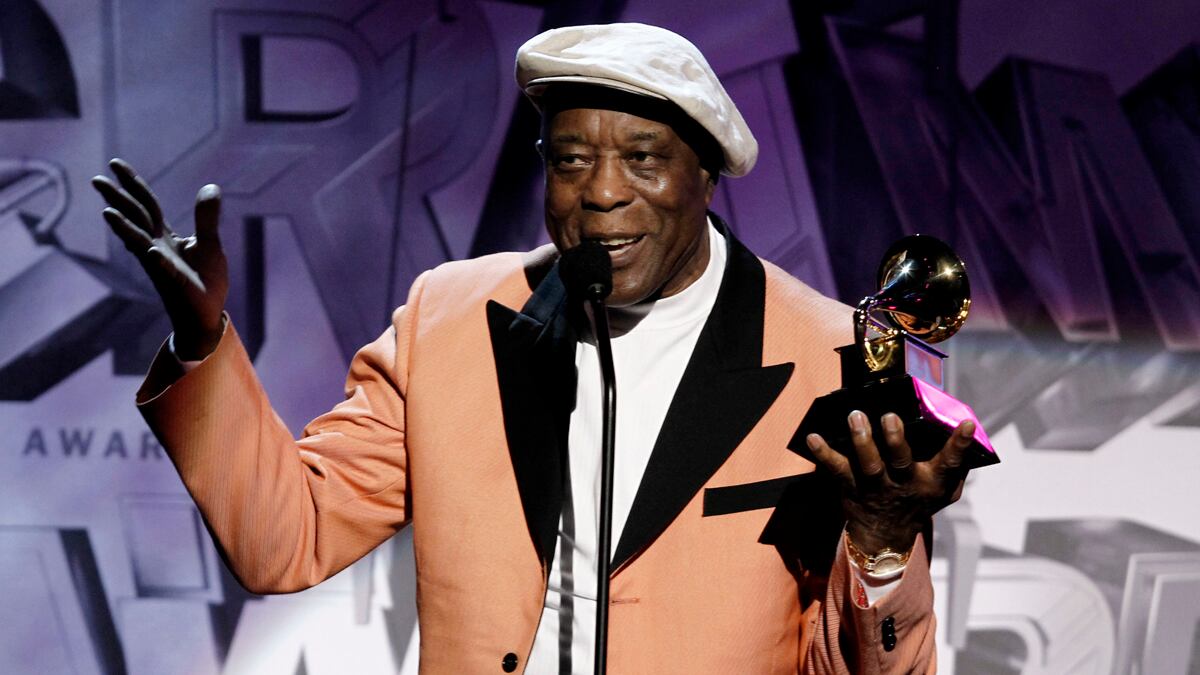The Rock and Roll Hall of Fame inductee Buddy Guy nearly abandoned his career before it even started.
In the winter of 1958, several months after he had arrived in Chicago from Baton Rouge, the 21-year-old Guy found himself unemployed, broke, and without a room of his own. Wandering through the city streets on a frigid night, not having eaten a meal in two days, Guy thought about calling his family in Louisiana to ask for train fare back home. “And I would’ve done it if someone had just loaned me a dime,” Guy said. “Thank God they didn’t.”
Serendipitously, a stranger approached Guy and asked him if he knew how to play the guitar strapped across his back. When Guy answered affirmatively, the stranger brought Guy to his apartment to strum some tunes for his wife. Impressed by Guy’s virtuosity on the guitar, the couple took him to the 708 Club, a well-known blues establishment on the city’s south side. The guitarist Otis Rush was on stage at the time, and he agreed to let Guy perform a song alongside him. Sensing an opportunity, Guy whipped the audience into a frenzy with the raucous theatrics that would later define his live style: racing across the stage, picking the guitar behind his back, blazing through extended solos. The owner of the 708 Club instantly took notice. As Guy remembered, “He started telling people there, ‘I don’t know who the hell that is, but hire him.’”
The owner went one step further and rang Muddy Waters, arguably the most esteemed figure from the mid-century Chicago blues scene. Upon leaving the stage, Guy was escorted outside to a cherry-red station wagon, where Waters greeted him with a freshly sliced salami sandwich. During their talk, Guy confessed to Waters that he was thinking of asking his family to loan him money for a ticket back to Louisiana, but Waters assured him that was no longer necessary. He had just made a home for himself in Chicago.
In his ramblingly entertaining memoir, When I Left Home: My Story, Guy relates this anecdote with a sense of awe, as if he still can’t believe how that fortuitous night unfolded. As a teenager, Guy had revered those Southern masters who had migrated to Northern cities like Chicago and, along the way, transformed the blues from an acoustic rural form to an electrified urban sound. By the time Guy arrived in the Windy City, many of those same musicians—Muddy Waters, Howlin’ Wolf, and Little Walter, among others—were still fixtures in the city’s rowdy nightlife. In his memoir and during our interview, Guy continued to speak of these forebears in reverential tones, which at times undercut his own sizable contributions to the genre. After all, it was Guy’s fretwork and onstage pyrotechnics that helped push the blues into new sonic territories. It’s no surprise that less than a decade after his arrival in Chicago, budding blues rockers like Eric Clapton and Jimi Hendrix were paying homage to the Louisiana-born musician whose propulsive sound had paved the way for them.

Guy was born in 1936 to a family of sharecroppers in the small town of Lettsworth, Louisiana. The first guitar music he heard as a child came from a two-string acoustic that a family friend named Coot used to play. “[Coot] came by every Christmas, and he could play a lot of Lonnie Johnson stuff and a few Lightnin’ Hopkins licks,” Guy recalled. “They’d drink a bottle of wine and get drunk, and while all the rest of the kids were playing with toys, I’d pick that guitar up and try to figure out what the hell he had did.”
Soon, Guy started constructing his own guitars from screen wires, tin cans, and scrap wood. “I would strip the wires off the screens over my mom’s windows and just try to make some kind of sound from them. I’d drive a few nails and tacks in them and stretch the wires as tight as I could.” When Guy turned 14, his father bought him Coot’s acoustic and then sent him to live with his sister in Baton Rouge. While there, he taught himself to play licks on those two strings from blues artists he heard on the radio. At one point, while he was practicing on his sister’s front porch, a passerby commented that Guy had talent but would need a six-string guitar to truly excel. The next day he unexpectedly gifted Guy a $50 guitar.
Guy was drawn to the amplified blues being broadcast on the radio in the early 1950s, and began imitating popular guitarists ranging from John Lee Hooker, B.B. King, and T-Bone Walker. “My thing was: Just learn to play like B.B. and T-Bone,” Guy told me. “But I wasn’t listening to just one person. If you’ve ever been to Louisiana, you know we have a dish there called gumbo. You know what that was before it became a delicacy? That was scrap that black people threw into a pot and added some seasoning to. So I compare my guitar playing to the gumbo. I copied something from everybody.”
But Guy didn’t fully find his musical style until he attended a concert in Baton Rouge by Guitar Slim, a flamboyant musician who had a hit single called “The Things I Used to Do.” As Guy remembered, “When they introduced him—‘Ladies and gentlemen, Guitar Slim!’—all I heard was a guitar. I didn’t see nobody. But then I saw this heavyset guy carry [Guitar Slim] through the back door on his shoulders like he was a child, just playing the guitar like that with a hundred-foot cord.” Sporting a red suit, red shoes, and dyed red hair, Guitar Slim thrilled the crowd with his booming Stratocaster and outrageous antics: writhing on stage, playing the guitar over his head, dangling from the rafters. Guy was mesmerized. “Man, that was in 1954, and I said to myself, ‘I want to play like B.B. King, but I want to act like Guitar Slim.’”

Over the next few years, Guy worked a series of manual labor jobs during the day and honed his act at night. He purchased an electric guitar and an extra-long cord, and practiced working a crowd and swaggering in from the street at the start of each show like Guitar Slim. But with little money coming in, Guy’s thoughts turned to Chicago. “I was working at LSU, and someone told me I could do the same thing in Chicago and make three times the money,” Guy recalls. “They told me I could work days and go watch Muddy and the others play at night.”
Of course, Guy would do more than simply watch Muddy Waters perform. After his meeting with Waters outside the 708 Club, Guy became a regular on Chicago’s vibrant blues scene. He gained a reputation as a wildly unpredictable showman who played rapid-fire instrumental solos, roamed through the audience during his set, and augmented his explosive sound with substantial feedback and distortion. When the mood struck, Guy would pick the strings with his teeth, or slap a handkerchief against the guitar for effect. These kinetic performances were a form of controlled chaos that would shape the look and sound of blues and rock for decades to come.
At the same time, Guy became a trusted house musician at Chess Records, the legendary Chicago label. “They used to call me into their sessions, and I think I’d make 15 or 20 dollars to make a record behind Wolf or Muddy or one of those famous guys.” As a versatile sideman, Guy tempered his live style in order to blend in with the more established Chess artists, which earned him the confidence of Leonard Chess, the label’s co-founder.
This confidence, however, did not carry over to Guy’s solo recordings. Leonard Chess strongly preferred blues with clean guitar runs and minimal distortion, and dismissed Guy’s expressive live style as unmarketable “noise.” Even though he managed to produce gems such as “The First Time I Met the Blues” and “Stone Crazy,” Guy was frustrated that he couldn’t let loose on his albums like he did on stage. “[Chess Records] wasn’t ready for the type of guitar I was playing,” Guy proclaimed. “They had the Wolf, Muddy, Little Walter, and all them, so they was looking at me like, ‘Sorry, we got everything we need. We don’t need your loudness.’”
It wasn’t until rock bands in the 1960s brought Guy’s distorted, freewheeling sound into the mainstream that Leonard Chess admitted he’d been wrong to stifle Guy’s playing style. As Guy recalled, one day “I walked in [Leonard Chess’s office] and he popped in an album. I think it was by either Cream or Hendrix. And then he bent over and pulled his coat up and said, ‘Buddy, I want you to kick me in my butt.’ … He said, ‘You’ve been trying to give us this ever since you came here.’”
Regardless, Guy continued to struggle over the next few decades to capture the spirit of his live style on an album. Despite the inspired records he made with the blues harmonica player Junior Wells in the 1960s and 1970s, it wasn’t until the 1991 release of Damn Right, I’ve Got the Blues that Guy would garner a level of mainstream recognition equal to his musical influence. The album netted him the first of six Grammy Awards and, more importantly, gave him the artistic freedom to pursue his own sound. As he states in his memoir, “If you listen to the album right, what you hear is a man used to wearing handcuffs flying free as a bird.”
The heyday of Chicago blues may have passed, but Guy, now 75, still keeps the tradition alive at Legends, the blues club that he owns in the city’s South Loop area. “There are very few blues clubs surviving, and I just want to keep something that Chicago owns,” he said. “Blues is not being played on the radio anymore. These young people don’t know nothing about it. Why would you want to be like Buddy Guy? My own children didn’t even know who I was until they turned 21 and saw me play. They said, ‘Dad, I didn’t know you could do that.’”
But Guy never gave up during his years of frustration at Chess, and he’s not giving up on the blues now. “I want it to keep going even when I’m gone. Just keep it rollin’. I don’t know nothing else to do.” He paused. “Someone asked me about playing in the White House a little over a month ago with B.B., and I said, ‘That’s a long way from picking cotton.’”





